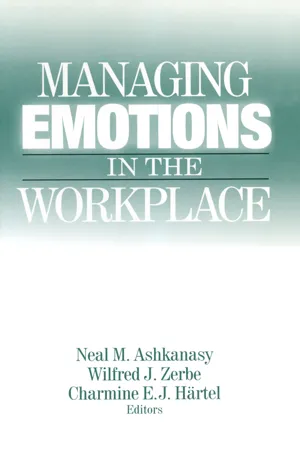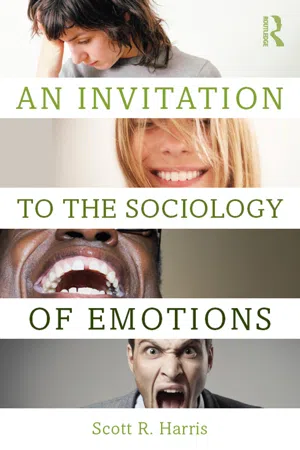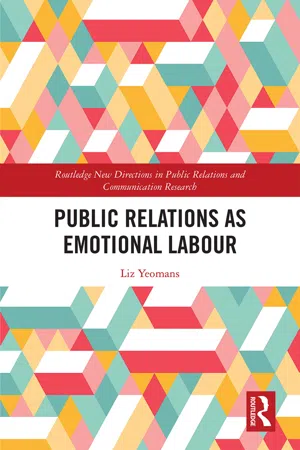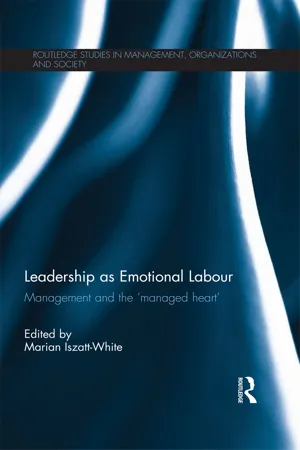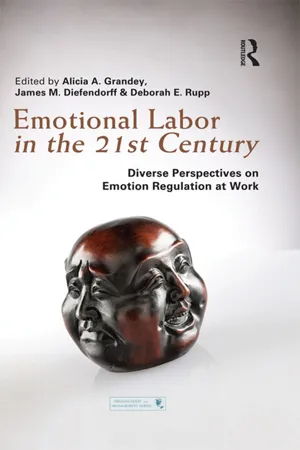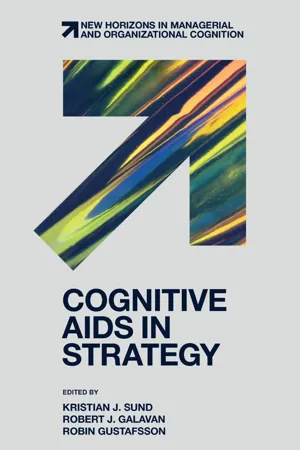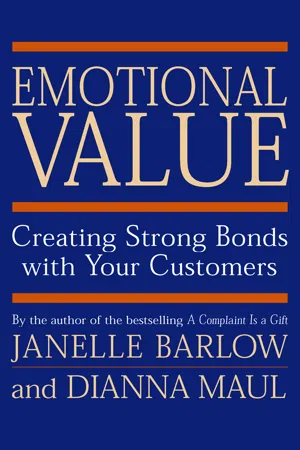Business
Emotional Labor
Emotional labor refers to the effort and energy required to manage and regulate one's emotions in a professional setting. This can involve displaying specific emotions, such as empathy or enthusiasm, to meet the expectations of clients, colleagues, or customers. It often involves suppressing one's true feelings and requires a significant amount of mental and emotional energy.
Written by Perlego with AI-assistance
Related key terms
11 Key excerpts on "Emotional Labor"
- eBook - ePub
- Timothy L. G. Lockyer(Author)
- 2013(Publication Date)
- Routledge(Publisher)
After the literature review in the area of Emotional Labor it has been found that no previous studies have been done on Emotional Labor in the Indian context. This study’s intent is to fill the lacunae in the Emotional Labor research in India. In this chapter the relationship between affectivity and Emotional Labor will be examined, as will the influence of Emotional Labor on job satisfaction and emotional exhaustion in the Indian context. The study has been done in Kochi, Kerala, a southern state in India.THE SERVICE CONTEXTAccording to the services management literature, the concept of Emotional Labor has particular relevance to service encounters for several reasons (Bowen and Schneider, 1988; Bowen et al., 1990, Brown et al., 1991). Frontline service personnel are situated at the organization-customer interface, and, thus, they represent the organization to customers. Service transactions often involve face-to-face interactions between service agents and customers. Given the uncertainty created by customer participation in the service encounter, such encounters often have a dynamic and emergent quality. The services rendered during an encounter are relatively intangible, thus making it difficult for customers to evaluate service quality. These four factors place a premium on the difficulty for customers to evaluate service quality. These four factors place a premium on the behavior of the service agent during the encounter, and this behavior often strongly affects customers’ perceptions of product quality, both of goods and services (Bowen et al., 1989).LITERATURE REVIEWEmotional LaborWhen the job roles require jobholders to display particular emotions and suppress others, jobholders do their own emotion management for a wage. Hochschild (1983) termed this regulation of one’s emotions to comply with occupational or organizational norms as “Emotional Labor.” She defined Emotional Labor as the management of feeling to manipulate ones physical expressions such as facial expressions and therefore Emotional Labor is sold for a wage. Therefore it has an exchange value (Hochschild, 1983). - eBook - ePub
- Neal M. Ashkanasy, Wilfred J. Zerbe, Charmine E. J. Hartel(Authors)
- 2016(Publication Date)
- Routledge(Publisher)
Hochschild added the term Emotional Labor to capture a very specific meaning associated with the management of emotions, namely being paid to manifest a specific emotional state as part of one’s job (Hochschild 1983). A review of the organizational literature addressing the sociology of emotions reveals the use of all three terms. However, there has been a distinct shift in how these terms are used in the organizational literature that “obscures the variability in work role emotional demands” (Wharton and Erickson 1993, 457–458). In other words, we manage our emotions in the workplace both to benefit ourselves and to benefit the organization. Furthermore, we are sometimes expressly required to manage our emotions as part of our job, and other times do so because it benefits us directly, making work more enjoyable, meaningful, or less stressful. While both actions occur in the workplace, they spring from different sets of demands and thus are important to differentiate in studies of emotion in organizations (Callahan 2000a; Lively 2000). In much of the recent literature, however, “Emotional Labor” has been used to describe both functions, thus obscuring the distinctions between them. This chapter explores the theoretical underpinnings of the two terms, presents a framework for clarifying the distinctions found in emotion management actions, and describes several typical organizational interventions that have implications for emotion management. Theoretical Underpinnings Hochschild (1979, 1983) used the general term emotion work to refer to any attempt to modify the experience or expression of a consciously felt emotion - eBook - ePub
- Scott Harris(Author)
- 2015(Publication Date)
- Routledge(Publisher)
5EMOTIONAL LABORSo far we’ve discussed three social dimensions of emotion: norms, management, and exchange. In this chapter, we’ll build on these three concepts as we turn to a new topic—Emotional Labor.Let’s ease our way into the subject by returning to the tentative distinction (discussed in chapter 1 ) between thinking, acting, and feeling. By extrapolating from each term, we might distinguish (loosely) between three kinds of labor. Cognitive labor would draw attention to the concentration and thought that certain tasks require, such as diagnosing a disease, navigating a tax code, or bidding on a bathroom remodel. Physical labor highlights circumstances where people must use their strength and manual dexterity to get their jobs done, perhaps by hammering nails, lifting boxes, assembling hamburgers, or even amputating a gangrenous leg. The concept of Emotional Labor, in turn, can help us recognize another dimension of paid employment.Put succinctly, people perform Emotional Labor whenever they manage emotions in their occupations. Workers frequently use surface acting and deep acting in order to experience and display the feelings that their jobs require. For example, a waitress may need to suppress impatience (with slow customers), disguise boredom (due to monotony), or feign cheerful enthusiasm (when lethargic). Neither the waitress nor her employer may possess a technical vocabulary for explicitly discussing this labor, besides relatively vague expressions such as “having a good attitude” or “buttering up customers” (Hallet 2003). Nevertheless, a worker’s ability and willingness to effectively perform Emotional Labor can determine whether she is hired or fired, and can have a direct impact on the size of the tips that customers leave.Emotional Labor is most apparent in those jobs that require workers to interact directly and frequently with customers (Leidner 1999). Occupations such as hostesses, cashiers, telemarketers, and hair stylists, come to mind. Or, imagine casino card dealers: these workers engage in friendly conversation for several hours a day as they administer a game that systematically subtracts cash from customers’ wallets (Enarson 1993; Sallaz 2002). People who sell cars, homes, cell phones, shoes, and other products might also engage in a great deal of emotion management (Prus 1989). - eBook - ePub
- Liz Yeomans(Author)
- 2019(Publication Date)
- Routledge(Publisher)
exchange value ’ (Hochschild, 1983, p. 7). Hochschild estimated that roughly one-third of American workers had jobs that subjected them to high demands for emotional labour, and that half of all women’s jobs called for it. She identified that the middle classes, especially in Anglo and Northern European cultures, were traditionally socialised for jobs involving a high degree of emotion management.Hochschild (1983) consciously used the term ‘emotional labour’ synonymously with ‘emotion management’ and ‘emotion work’; however these latter terms, according to her footnote on page 7, refer to the management of feeling in the private realm rather than the commercial context: i.e. where there is ‘use value’ or utility instead of ‘exchange value’. ‘Use value’ is not clearly defined but Hochschild appears to suggest that emotion management and emotion work equip the individual with a sense of agency and choice of when to manage emotion in social contexts, whereas emotional labour subjects the individual to an emotional script prescribed by the commercial context. The choice of term, nevertheless, connotes different meanings: for example, Bolton (2005) was criticised by Brook (2009) for preferring the less political term emotion management over emotional labour. Therefore, it is crucial to first examine the genesis of Hochschild’s emotional labour concept before moving on to discuss these different terms, which I return to later in this chapter.Hochschild’s position appears to stem from the first line of the first chapter where she references Das Kapital in which Marx examined the working conditions of child labourers in the nineteenth-century English factories (Hochschild, 1983, pp. 3–5). She suggests parallels between the physically exhausting conditions of Marx’s factories and the instrumental use of emotional labour by twentieth-century commercial institutions, whereby the worker becomes increasingly estranged or alienated from a sense of self. The alienating processes of factory work, referred to by Marx, literally separated workers from the products of their labour (thus rendering them powerless), while the imposed nature of production work took away self-expression or meaning in the labour process (see the discussion on workplace alienation on page 22). The main tenets of her argument are that the strain exerted on the worker by the commercialisation of feeling may lead to a loss of the authentic self, to the extent that commercial systems appropriate - eBook - ePub
Building Service-oriented Government: Lessons, Challenges And Prospects
Lessons, Challenges and Prospects
- Wei Wu(Author)
- 2012(Publication Date)
- WSPC(Publisher)
Service exchanges between worker and citizen require the worker to sense the right tone and medium for expressing a point and/or feeling and then to determine whether, when, and how to act on that analysis. To ignore this combination of analysis, affect, judgment, and communication is to ignore the social lubrication that enables rapport, elicits desired responses, and ensures that interpersonal transactions are constructive.In Newman, Guy and Mastracci’s previous research on Emotional Labor, they discovered several important dimensions of Emotional Labor. First, at varying levels of intensity, it plays a role in nearly all government jobs. Civil servants probably recognize that the work entails emotion work, even though they may not be familiar with the term Emotional Labor itself. Frontline workers deal with the day-to-day needs of an increasingly demanding public; management handles the inter- and intra-agency demands of subordinates and superiors on everything from budget and human resources to agency turf battles. Second, they found that the performance of Emotional Labor need not lead to burnout. Public servants are as energized by intense Emotional Labor demands as they are exhausted. The difference lies in how management and workers address the emotive labor demands of these jobs. This led them to a third conclusion: Emotional Labor is part of an occupation, not simply something that a person brings to the job (or not) — compared with emotional intelligence, which is located in the person. The characteristics of the job — its purpose and role in the organization, its demands and requirements — determine whether or not job holders will find themselves exerting Emotional Labor. This led to a fourth conclusion: Agencies can screen, train, retrain, and evaluate employees on the quality of Emotional Labor that they exercise on the job. But it is the rarest office that even recognizes the emotive demands of its workers, much less evaluates and compensates for them.3.3. The Relationship Between Emotional Labor and Burnout
- eBook - ePub
Emotional Intelligence at Work
18-year journey of a researcher
- Chi-Sum Wong(Author)
- 2015(Publication Date)
- Routledge(Publisher)
Emotional demands have received increased research attention with the growing dominance of the service sector. To perform a service job adequately, employees may be required to present particular types of emotion that differ from their true feelings. Faced with these emotional demands, employees must react through the “management of feeling to create a publicly observable facial and bodily display” (Hochschild, 1983, p. 7). For example, a flight attendant may be very unhappy but must still present a friendly attitude and demonstrate a willingness to serve. Conversely, a debt collector may be very happy but still needs to present a tough expression. Managing emotions to perform a job adequately is referred to as “Emotional Labor.” The rules behind the presentation of emotions required by an organization or job are called the “display rules” (Ekman & Friesen, 1975; Goffman, 1959; Hochschild, 1983). Expression according to the display rules that contradicts genuinely felt emotions can result in emotional dissonance and can negatively affect employee well-being (Hochschild, 1983; Kinman, 2009).In the Emotional Labor literature, the possible coping reactions of employees to the emotional demands of their jobs are classified as either surface acting or deep acting (Grandey, 2000; Gross, 1998a, 1998b). Surface acting emphasizes the management of observable expressions, whereas deep acting emphasizes the management of true feelings. When using surface acting, employees present the required emotions without aligning these emotions with their true inner feelings. They thus experience alienation from their true emotions, which results in a high level of strain. When using deep acting, employees consciously modify their feelings to express the desired emotion, thereby avoiding the alienation from their true emotions and reducing the strain. Empirical evidence has demonstrated that these two Emotional Labor strategies have different relationships with employee burnout (e.g., Brotheridge & Grandey, 2002; Grandey, 2003; Gross & John, 2003; Totterdell & Holman, 2003).There are three components of burnout: exhaustion, depersonalization, and reduced personal accomplishment. We concentrate our discussions on the exhaustion component, because exhaustion is usually regarded as the core component of burnout and the cause of the other two components (Leiter & Maslach, 1988; Maslach, 1982; Maslach, Schaufeli, & Leiter, 2001). According to Schaufeli, Maslach, and Marek (1993), exhaustion is an action whereby one distances oneself emotionally and cognitively from one’s work. It is related to psychosomatic complaints, depression, and other long-term effects of stress (Maslach et al., 2001; Schaufeli & Enzmann, 1998). - eBook - ePub
Emotions and English Language Teaching
Exploring Teachers' Emotion Labor
- Sarah Benesch(Author)
- 2017(Publication Date)
- Routledge(Publisher)
A departure from a psychological perspective on emotions as exclusively internal states, “emotion labor” acknowledges that humans actively negotiate the relationship between how they feel in particular work situations and how they are supposed to feel, according to social expectations. Of course the question of “how they feel” is a vexed one because it can be understood in various ways, some more psychological and others more social, as outlined in Chapter 2. At the end of this chapter, I make clear how I reconciled varying definitions of emotion labor as I did with different ways of theorizing emotions in the previous chapter. Originally coined by sociologist Arlie Hochschild, emotion labor has been taken up by scholars in a range of fields: business, communications, criminology, geography, political science, education, economics, and so on. The breadth of this research is a tribute to emotion labor’s conceptual flexibility and its enduring usefulness as a tool for examining emotions from a social perspective. By proposing a number of related terms—emotion management, feeling rules, surface acting, deep acting, and, later, emotion labor—Hochschild (1979, 1983, 2012) aimed to merge sociological and psychological concepts circulating during the mid-twentieth century, especially drawing on the work of Erving Goffman and Sigmund Freud. That is, she posited both display rules (sociology) and an inner self (psychology) that works consciously on emotions to bring them in line with those rules. Her main contribution was to explore the implications for workers when their emotions are commodified to maximize their workplace performance. To account for the processes by which individuals experience, monitor, assess, transform and/or maintain their emotions in response to social situations and norms, Hochschild (1979) first proposed emotion management - eBook - ePub
Leadership as Emotional Labour
Management and the 'Managed Heart'
- Marian Iszatt-White, Marian Iszatt-White(Authors)
- 2012(Publication Date)
- Routledge(Publisher)
5How leading with emotional labour creates common identitiesRonald H. HumphreyIntroduction: Emotional labour, leadership, and identityEmotional labour is a concept that was originated by Hochschild (1979, 1983). She defined emotional labour as the ‘management of feeling to create a publicly observable facial and bodily display’ (1983: 7). Hochschild (1983) focused on how service workers, such as airline flight attendants, were required to display emotions as part of their job duties. For example, many service workers are told to smile and act friendlily towards customers (Pugh, 2001). Because emotions are contagious, service workers who display positive emotions may spread their positive emotions to customers and boost customer satisfaction with service quality. Rafaeli and Sutton (1987; 1989) were also among the first scholars to study emotional labour, and they argued that organizations set emotional display rules that govern what emotions must be displayed to customers (they argued that organizations can regulate only observable external displays, and not internal emotional states). Display rules increase predictability and make service interactions go more smoothly; when display rules conform to normal social expectations, both parties (service agents and customers) understand what emotions should be displayed and how they should treat each other. Thus display rules guide interactions between people and increase efficiency (Ashforth and Humphrey, 1993; Rafaeli and Sutton, 1989). As conceptualized in these early studies, emotional labour was something performed by front-line service workers – those who had direct contact with customers – and not by managers or leaders. As a result of these influential publications, almost all subsequent work has been on how service workers perform emotional labour. - eBook - ePub
Emotional Labor in the 21st Century
Diverse Perspectives on Emotion Regulation at Work
- Alicia Grandey, James Diefendorff, Deborah E. Rupp, Alicia Grandey, James Diefendorff, Deborah E. Rupp(Authors)
- 2013(Publication Date)
- Routledge(Publisher)
A key assumption of this lens is that requiring emotions in exchange for a wage is uniquely distressing to employees. This is examined in two broad ways: 1) comparing outcomes for employees in high-EL and low-EL occupations, and 2) comparing financial motives versus other motives for performing emotion work.Hochschild stated that “Emotional Labor is sold for a wage … I use the synonymous terms emotion work or emotion management to refer to these same acts done in a private context” (p. 7). She recognized that emotional displays are used strategically in many social contexts (Goffman, 1959 ); however, when emotions are used for financial gain “feelings are commoditized” (1979, p. 569), and this has unique effects on the employee. Lively and Powell (2006) found that emotion display requirements were more rigidly held at work (for pay) but this was unrelated to strain; this is in comparison to emotion display requirements held at home, which have, in contrast to Hochschild’s proposal, been argued to be less rigidly held but more contributive to job strain (Wharton & Erickson, 1995 ). Surprisingly little research has assessed the assumption that performing emotion management for financial gain has personal costs (Wharton, 2009 ). Across occupations, EL demands are negatively related to wages, except for in professional jobs with higher cognitive demands (Glomb, et al., 2004 ); thus, the financial outcome of performing EL depends on job status. Financial motives for engaging in EL, however, may depend on the type of occupation. Sociologists have argued that caring professionals have a unique experience with regard to Emotional Labor (see Erickson & Stacey, 2013 ). Specifically, they are more likely to engage in EL for professional (to uphold professional norms of conduct) or philanthropic (to provide a “gift” to the patient) motives, rather than presentational (to conform to broadly held social norms), or pecuniary (to obtain financial benefits) motives (Bolton & Boyd, 2003 - eBook - ePub
- Kristian J. Sund, Robert J. Galavan, Robin Gustafsson, Kristian J. Sund, Robert J. Galavan, Robin Gustafsson(Authors)
- 2023(Publication Date)
- Emerald Publishing Limited(Publisher)
Hochschild (1975 , p. 289) links emotions to labor via occupations, noting that “[d]ifferent occupations trade on different types of emotional skill – inducing and expressing emotion for the actress, understanding or interpreting it for the psychiatrist, disguising it for the poker player.” While it is premature to make this parallel fully, if experience is any teacher, then all of these states – inducing, interpreting, and disguising emotions – land soundly in the daily toolkit of the skilled facilitator of scenario planning.A precursor and partner term to “Emotional Labor” is “emotion work,” first alluded to in Hochschild’s (1975) piece and elaborated upon, expertly, in Hochschild’s (1979) “Emotion Work, Feeling Rules, and Social Structure.” Emotion work is the means by which individuals exercise control over their expression and presentation of emotions during human interactions. While there is significant sociological attention on the self-management of emotional self-expression within social structures, Hochschild (1975 , p. 302) was one of the first scholars to acknowledge5 that “[o]rganizations [i.e., social groups] also do ‘emotion work;’” to wit, “[m]any aspects of bureaucracy (e.g., written communication, secrecy patterns) serve a variety of emotional functions that supposedly foster the smooth flow of work and affective neutrality.” Although it is not until Hochschild’s (1983) The Managed Heart , subtitled The Commercialization of Human Feeling , that the socio-economic notion of “Emotional Labor” was fully articulated and empirically explored. In that work, Hochschild unlocks the economic aspects of emotions and the related psycho-emotional aspects of work, labor, and occupations. Hochschild (1983 , p. xvii) credits writings from sociologist C. Wright Mills (2002 [1951]) and the book chapter “The Great Salesroom” in the book White Collar - eBook - ePub
Emotional Value
Creating Strong Bonds with Your Customers
- Janelle Barlow, Dianna Maul(Authors)
- 2000(Publication Date)
- Berrett-Koehler Publishers(Publisher)
63CHAPTER FOUREmotional Labor OR EMOTIONAL COMPETENCE?
Maureen O’Hara sits in an old-fashioned office chair, dressed all in black, looking resolute as she is interviewed for the brisk-selling business magazine The Fast Company. Dean of faculty at San Francisco’s Saybrook Graduate School and postmodern psychologist par excellence, Dr. O’Hara makes a strong case for the necessity of emotional skills at the turn of the twenty-first century.Everyone must become a student of human nature in all its glorious complexity. Exercising new psychological muscles—tolerance, flexibility, empathy— becomes part of developing competence at work.1Exercising new psychological muscles—tolerance, flexibility, empathy— becomes part of developing competence at work.Contrast this message with that of Arlie Russell Hochschild in The Managed Heart, as she discusses Emotional Labor:This [emotional] labor requires one to induce or suppress feelings in order to sustain the outward countenance 64 that produces the proper state of mind in others—in this case, the sense of being cared for in a convivial and safe place.2Are these two viewpoints, expressed over a period of fifteen years, with one seeing emotional competence as a “glorious” skill set and the other viewing it as a emotional “burden,” merely two different opinions about service work? Or do O’Hara and Hochschild, the spokespeople we have chosen to represent these two points of view, speak to fundamental and divisive beliefs about the nature of service? We think it is the latter.It is up to organizations to create a context in which meaningful relationships can occur in the service exchange.In fact, we contend these points of view reflect a chasm that puts management and service staff on opposite sides and is so deep that it must be
Index pages curate the most relevant extracts from our library of academic textbooks. They’ve been created using an in-house natural language model (NLM), each adding context and meaning to key research topics.

